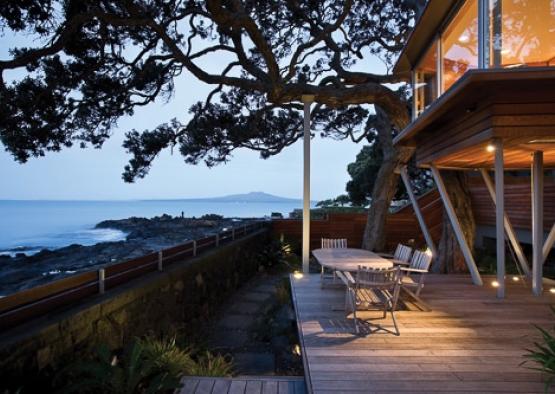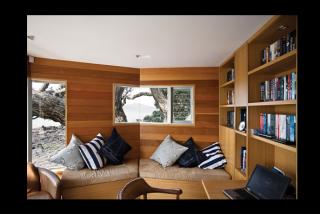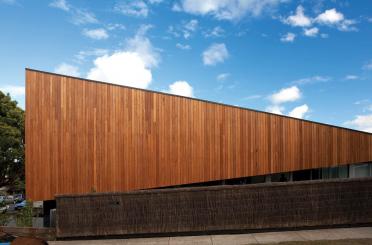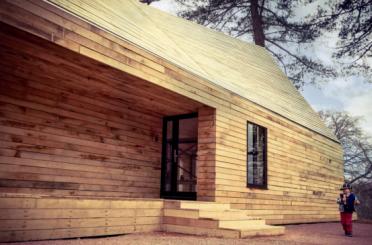
Overview
Five well-established pohutukawa (New Zealand's native 'Christmas tree') trees inhabit the site, their intertwined limbs spreading across the seaward half of the available building zone. A tight access lane drops at a very steep 1:3 'slope' - plus, just for good measure, much of the site is volcanic rock.
The desire not to damage the trees or their extensive root systems, combined with the steep slope and limited turning circle for cars, the rock outcrops and the restrictions of height-to-boundary controls required complex analysis to formulate the actual building possibilities.
The result is an innovative home - squeezed under, around and between the limbs of the trees - and still taking full advantage of the site, sun and the views.
Story and pictures by special arrangement with timber+DESIGN International magazine (www.timberdesignmag.com).
Structure
The house is designed to change its character as it rises skyward. The ground floor level comprises orthogonal spaces, which follow the slope in a series of steps towards the sea - providing sea views from each level. The lowest level (the living room) is set to ensure views across a stone boundary wall.
Upstairs, the rooms become more angular and free flowing to reflect the contortions of the tree limbs.
Living, dining/kitchen area, theatrette, laundry, bathroom and double garage are on the ground floor.
The upper floor has three bedrooms, two bathrooms and a library, with the main bedroom opening onto an extensive rooftop terrace, that weaves between the tree branches.
The library is projected towards the sea like a tree house among the pohutukawas - propped on asymmetrical steel columns, the bases of which are carefully located to avoid tree roots.
Much of the ground floor slab is supported by a limited number of foundations - also located to avoid tree roots. An irrigation system under the slab provides the equivalent amount of water to the roots as if the house had not been built.
Exterior
Extensive use of timber reflects the importance of the existing trees on the site and provides visual warmth and softness. The exterior cladding is integral to the design and continues inside the house. Cedar battens act as a rain screen outside and line the walls of the double-height interior stairway.
The cladding is carefully detailed, with the envelope clad in plywood on cavity battens, and then a rain screen of open-jointed 130 x 20 mm cedar boards.
All cedar, oak and other construction timber was obtained from certified sustainable sources.
Interior
Inside the house, the theme established by the exterior cladding continues. Cedar battens, that act as a rain screen outside, line the walls of the double-height interior stairway.
The timber lining, in a non-yellowing clear finish, continues along the upper-level hall, and leads the visitor through the house to a glazed link to the library.
The library walls are also cedar-clad with cedar boards and evoke the feeling of being inside a tree house, perched high in the spreading branches. Because the room is positioned between protected limbs of an established tree, specially designed cabinetry was required to fit its angular shape.
Oak bookshelves, a fold-down desk and built-in day bed with oak veneer base are part of the joinery of the unusually shaped room - also creating a sense of welcoming intimacy in the library.
The client wanted warm and inviting interior spaces so the architects specified oak flooring, which runs through the living/dining areas and up the stairs.



